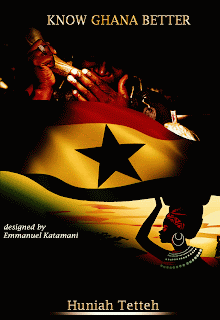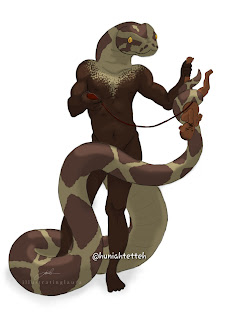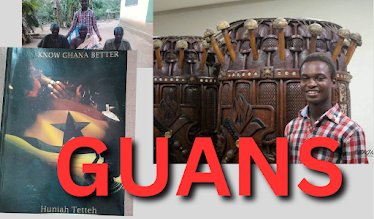THE AKYODE PEOPLE OF GHANA
(Know Ghana Better 2021)
The Atsode are closely related to the Nawuri, Gonja, Semere, Alijo, Anyanga and Ntsumburun but then the Adele and Ntrubo also have linguistic affiliations with the Atsode. The Atsode call their Guan Gikyode. The whites misspelt Atsode as Ajuati which has been a way other tribes have come to know the people of Atsode. To begin, Nana Angyefune of Atsode stated that the Guans were led by their gods to their present settlements. This is because Guans hate bloodshed and it is an abomination for them to see blood being shed on their lands. Hence if anyone gets into any misunderstanding with another and there is bloodshed, then Guan customs demand the slaughter of a ram to appease their gods. This is also very typical of the Ga people who abhor bloodshed on their lands; where the Guans once lived. Hence at Nungua, should there be bloodshed whether openly or secretly and no cleansing rites are performed, during the final Kplejoo festival, the elder priests (Gborbu priests) would never get possessed and pacification rites have to be performed so as to appease the gods.
Nana Angye of Atsode furthered that Guans moved from Ga land to Akuapem
and settled on mountains and non-obvious places so that their enemies would not
be able to get to their communities and spill blood. Thus the name Akyiwede which
means “abomination” or “taboo” became the name of the Atsode tribe. Atsode came
to existence because the whites misspelt Akyiwede as Atsode and it was made
official.
The Atsodes used to descend to farm at present day Nkwanta and will go
back to their mountains until recently when the wars were over that they started
descending and mingling with their brothers. The Gonja, Nawuri, Krachi and Ntsumburun
were much closer to them than the Buems and Likpe. The Buems and Likpe people with
time lost their Akan accent and they spoke with the direct-toned accent.
There were two rivers where the Atsode used to go and fetch water. They
called one of the rivers “Ɔbo da mɔ akoŋ” meaning “the river that lies alone.”
Damɔakoŋ gradually became Damanko and Damanko presently have Kokombas and
Basaris settled on the land. Also they would normally say “kpa sa ntsu ba”
meaning “go and fetch water and come” thus “kpa sa” became the name of the
Basari populated town of Kpassa. Atsode history further elaborates that when
they were on the mountains the Kokomba-Basari people made settlements on their
lands and after they had descended, they met them but then they did not fight
rather, they have lived together in peace and in harmony even till date.
The Atsodes have their traditional capital at Shiare. Shiare is where
all rites and customs are performed among the Atsodes. Shiare is actually Sei ade. Sei is an Atsode god thus Seiade meaning “Sei’s people” have been
corrupted to Shiare.
Another Atsode community called Kyilinga was originally Tsagbala. Kyili
means “very deep” as it is said that for one to be able to descend the Atsode
hills to Tsagbala, it was a very deep valley hence in Atsode it is said as Kyilingado has been officialised to Kyilinga.
The Atsode speaks the Gitsode language and it is furthered that the Atsodes,
Ntsumburuns and Nawuris understand each other better when speaking their various
Guan languages than they would understand Krachi. Well, perhaps this is so
because the Krachi migrated from Awutu-Bireku whereas the Atsode, Nawuri and Ntsumburun
migrated from Larteh-Akuapem.
Guans because of their origin like earlier
learnt are great speakers of the Akan language thus one Atsode community called
Kromase is Akan to mean “beneath our town.”
Keri is one of the most popular Atsode communities in the Oti Region. It
is said that during the migration of the Guans from Krachi to the Atsode
Mountains, they divided themselves into minor groups. Perhaps one group went
ahead without the knowledge of the others thus when the majority of the Atsodes
got to the mountains, they asked who they were and they said they were the
“Ayikeni” group. The name Ayikeni is
what was misspelt and mispronounced by the colonial masters as Keri.
The Atsode communities include Shiare, Kyilinga, Kromase, Gekrokrong,
Keri, Pawa, Abrewanko, Nyambong, Bonakye, Nkwanta, Kpassa, etc. The Atsode worship their elder god “Brukun”
at Shiare.
Now Gikyode is one Guan language that uses “nu” to express “inside” just
like the Nzema, Anyin, Brusa, Sefwi and Chakosi who also say it as “nu.” The
Buems say it as “mu.” Let’s look at how it is said in the other Guan languages
Efutu : tɔ
Awutu : tɔ
Gonja : to
Ntsumburun : lɔ
Larteh : te
Kyripon : tɛ
Nawuri : tɔ
Nkonya : tɔ
Shiare, the capital of the Atsode traditional area, is divided into two
factions; Kyagewi and Awukugewi. Kya and Awuku are two individuals who led the
two separate factions or better still gates of Atsodeman. The Ten clans of
Shiare are spread under these two factions. The clans under Kyagewi are four
and they are Danteso, Obanaso, Abonbondor and Kankamador. The others which are
under Awukugewi are gelarador, getenbidor, geporbidor,
gekedor, wesawesador, kubedor.
The Atsodes have their general totem which is the Leopard and it is
called “Bufuli” in the Gikyode language. In Shiare, the clans do not have
Totems but then some sort of representations for their clans. These
representations are seen in the names of the clans and to some extent the
history behind their origins.
We shall at this point have a look at the nine clans of Shiare. Then
again, one must note that all the clans of Atsode worship Brukun so the appellations
apply to all the clans irrespective of the area.
That is why for the appelations, there is no division in that part of
the table. All the Atsode clans use the same appelations
|
CLAN |
REPRESENTATIONS |
APPELATION |
|
Danteso |
Krachi
Dente Shrine |
Ogidigidi Panpango Masalemaba Oyele gebembe to gebembe Kyanbereki gemara oye ansi oye Gepe kyululu wura okɔmɔ okɔ gebee Obulufu mɔ obulufu gepase Mara akonde de mboe buruburu Gao |
|
Obanaso |
The
generation they come from |
|
|
Abonbondɔ |
Abonbon
tree |
|
|
Kankamadɔ |
Lemon
tree |
|
|
Gelaradɔ |
Baobab
Tree |
|
|
Geteŋbidɔ |
That
is the Royal Mausoleum |
|
|
Geporbi |
Geporbi
tree |
|
|
Wesawesador |
Wesawesa
tree |
|
|
Kubedor |
Coconut
tree |
COMMON COURTESY IN GITSODE
|
GADE |
TSULE |
WORD |
RESPONSE |
|
Ida nnɛ? |
Ibraŋ |
How is it? |
I am fine/it is
fine! |
|
Fu bɔ alanfia? |
Mbɔ alanfia! Alanfia bɔ nu! |
How are you? |
I am fine! |
|
Gile! |
Dɛɛnaŋ! |
Good morning! |
Good morning! |
|
Fɔ kyina! |
Fɔ ɔna! |
Good afternoon! |
Good afternoon! |
|
Anula! |
Saafa! |
Good evening! |
Good evening! |
|
Fɔre gesuŋ! |
Yoo! |
Thank you! |
Ok! |
|
Ntsa kulu fu! |
|
I beg you! |
|
|
Fɔ na! |
Yoo! |
Welcome! |
Thank you! |
|
Oral sources: Nana
Angyefune Mamine, Amankrado of Atsode Traditional Area; Bekinane Mathew, Acting Registrar of Atsode
Traditional Council; Nana Bayen
Asanyor II, Pawawura of Atsode Traditional Area; Nana Obombo Fewura Nipuwura, Shiarewura
|
|||







Comments
Post a Comment
Thank you! Gladly appreciate your feedback. You can also reach out personally via whatsapp or follow me on youtube/facebook Huniah Tetteh.